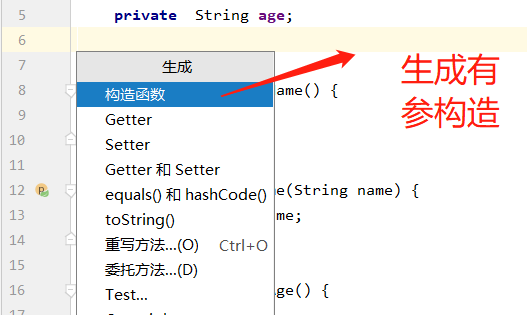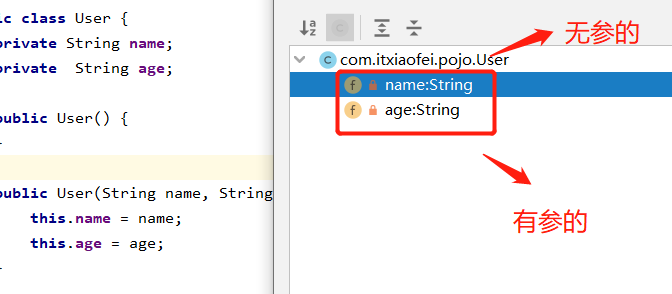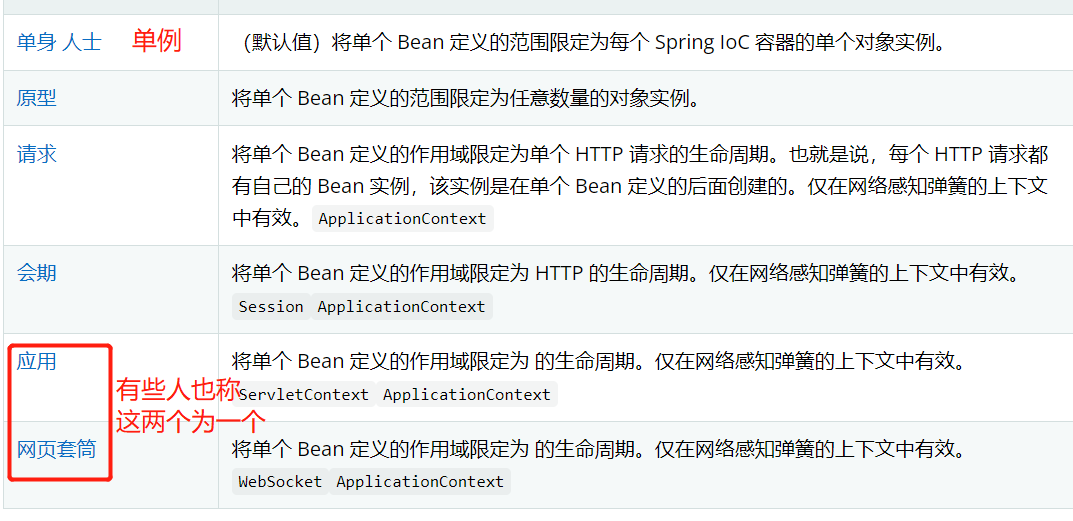6.依赖注入(DI)
6.依赖注入(DI)
1.构造器注入
2.set方式注入【重点☆】
依赖注入:set注入
依赖:bean对象的创建依赖于容器
注入:bean对象中所有属性,由容器注入。
【环境搭建】
1.复杂类型
public classAddress { private String address; publicString getAddress() { returnaddress; } public void setAddress(String address) { this.address= address; } }
2.真实测试对象
public classStudent { privateStringname; privateAddressaddress; privateString[]books; privateList<String>hobbys; privateMap<String,String>card; privateSet<String>games; privateStringwife;//空指针,有无妻子 privatePropertiesinfo;//学生信息 }
3.beans.xml
<?xml version="1.0"encoding="UTF-8"?> <beans xmlns="<http://www.springframework.org/schema/beans>" xmlns:xsi="<http://www.w3.org/2001/XMLSchema-instance>" xsi:schemaLocation="<http://www.springframework.org/schema/beans> <https://www.springframework.org/schema/beans/spring-beans.xsd>"> <bean id="student" class="com.itxiaofei.pojo.Student"> <!--第一种,普通值注入,直接使用value--> <property name="name"value="小飞"/> </bean> </beans>
4.测试类
public classAddress { privateStringaddress; publicString getAddress() { returnaddress; } public voidsetAddress(String address) { this.address= address; } }
完善注入信息:
<?xml version="1.0" encoding="UTF-8"?> <beans xmlns="<http://www.springframework.org/schema/beans>" xmlns:xsi="<http://www.w3.org/2001/XMLSchema-instance>" xsi:schemaLocation="<http://www.springframework.org/schema/beans> <https://www.springframework.org/schema/beans/spring-beans.xsd>"> <bean id="address" class="com.itxiaofei.pojo.Address"> <property name="address" value="山西"/> </bean> <bean id="student" class="com.itxiaofei.pojo.Student"> <!--第一种,普通值注入,直接使用value--> <property name="name" value="小飞飞"/> <!--第二种,bean注入--> <property name="address" ref="address"/> <!--第三种,数组注入--> <property name="books"> <array> <value>红楼梦</value> <value>水浒传</value> <value>西游记</value> <value>三国演义</value> </array> </property> <!--第四种,List--> <property name="hobbys"> <list> <value>听音乐</value> <value>敲代码</value> <value>打篮球</value> </list> </property> <!--第五种,Map--> <property name="card"> <map> <entry key="学号" value="1931030***"/> <entry key="电话" value="18104131***"/> </map> </property> <!--第六种,Set--> <property name="games"> <set> <value>英雄联盟</value> <value>地下城与勇士</value> </set> </property> <!--第七种,Null--> <property name="wife"> <null/> </property> <!--第八种,properties(特殊类型) key=value...--> <property name="info"> <props> <prop key="学号">1931030***</prop> <prop key="性别">男</prop> <prop key="姓名">小飞</prop> </props> </property> </bean> </beans>
3.拓展方式注入
生成有参构造:


我们可以使用p命名空间和c命名空间进行注入
官方解释:
p命名:

<beans xmlns="<http://www.springframework.org/schema/beans>" xmlns:xsi="<http://www.w3.org/2001/XMLSchema-instance>" xmlns:p="<http://www.springframework.org/schema/p>" xsi:schemaLocation="<http://www.springframework.org/schema/beans> <https://www.springframework.org/schema/beans/spring-beans.xsd>"> <bean name="classic" class="com.example.ExampleBean"> <property name="email" value="someone@somewhere.com"/> </bean> <bean name="p-namespace" class="com.example.ExampleBean" p:email="someone@somewhere.com"/> </beans>
测试:
@Test public static void main(String[] args) { ApplicationContext Context = new ClassPathXmlApplicationContext("Userbeans.xml"); User user = Context.getBean("user", User.class); User user2 = Context.getBean("user2", User.class); System.out.println(user); System.out.println(user2); }
缺点:p 命名空间不如标准 XML 格式灵活。例如,用于声明属性引用的格式与以 结尾的属性冲突,而标准 XML 格式则不然。我们建议您仔细选择方法并将其传达给团队成员,以避免生成同时使用所有三种方法的 XML 文档
c命名:
与带有 p 命名空间的 XML 快捷方式类似,Spring 3.1 中引入的 c-命名空间允许内联属性用于配置构造函数参数,而不是嵌套元素。
<beans xmlns="<http://www.springframework.org/schema/beans>" xmlns:xsi="<http://www.w3.org/2001/XMLSchema-instance>" xmlns:c="<http://www.springframework.org/schema/c>" xsi:schemaLocation="<http://www.springframework.org/schema/beans> <https://www.springframework.org/schema/beans/spring-beans.xsd>"> <bean id="beanTwo" class="x.y.ThingTwo"/> <bean id="beanThree" class="x.y.ThingThree"/> <!-- traditional declaration with optional argument names --> <bean id="beanOne" class="x.y.ThingOne"> <constructor-arg name="thingTwo" ref="beanTwo"/> <constructor-arg name="thingThree" ref="beanThree"/> <constructor-arg name="email" value="something@somewhere.com"/> </bean> <!-- c-namespace declaration with argument names --> <bean id="beanOne" class="x.y.ThingOne" c:thingTwo-ref="beanTwo" c:thingThree-ref="beanThree" c:email="something@somewhere.com"/> </beans>
缺点:由于 XML 语法,索引表示法需要存在 前导 ,因为 XML 属性名称不能以数字开头(即使某些 IDE 允许)。相应的索引表示法也可用于元素,但不常用,因为声明的简单顺序通常就足够了。
总结:在实践中,构造函数解析机制在匹配参数方面非常有效,因此,除非确实需要,否则我们建议在整个配置中使用名称表示法。p命名与c命名空间不能直接使用,需要导入xml约束。
xmlns:p="<http://www.springframework.org/schema/p>" xmlns:c="<http://www.springframework.org/schema/c>"
4.bean soupes(bean的作用域)


1.单例模式(spring默认机制)
<bean id="user2" class="com.itxiaofei.pojo.User" c:name="小飞学java" c:age="23" scope="**singleton**"/>
User user = Context.getBean("user2", User.class); User user2 = Context.getBean("user2", User.class); System.out.println(user==user2);

2.原型模式:每次从容器中get的时候都会产生新对象
<bean id="user2" class="com.itxiaofei.pojo.User" c:name="小飞学java" c:age="23" scope="**prototype**"/>
User user = Context.getBean("user2", User.class); User user2 = Context.getBean("user2", User.class); System.out.println(user==user2);






· 阿里巴巴 QwQ-32B真的超越了 DeepSeek R-1吗?
· 10年+ .NET Coder 心语 ── 封装的思维:从隐藏、稳定开始理解其本质意义
· 【设计模式】告别冗长if-else语句:使用策略模式优化代码结构
· 字符编码:从基础到乱码解决
· 提示词工程——AI应用必不可少的技术